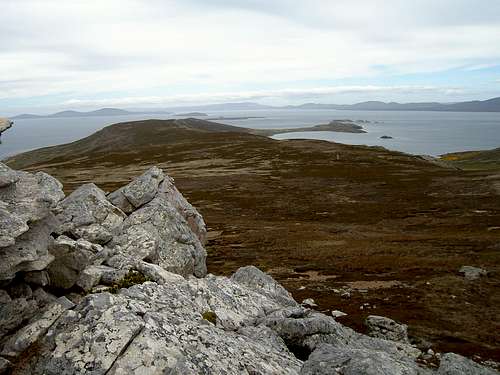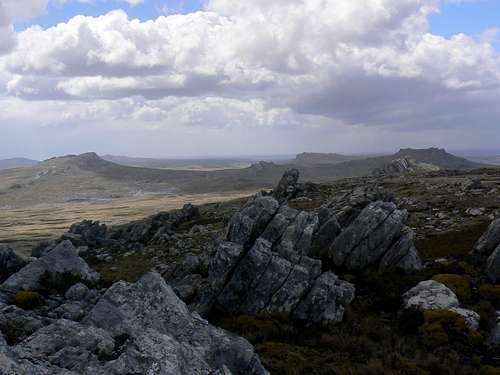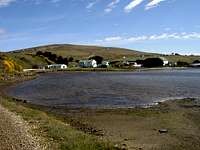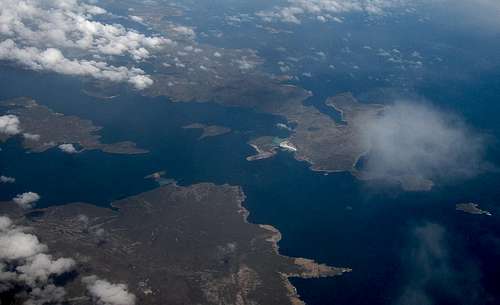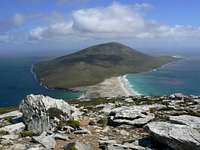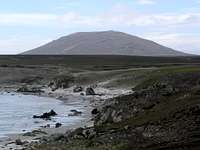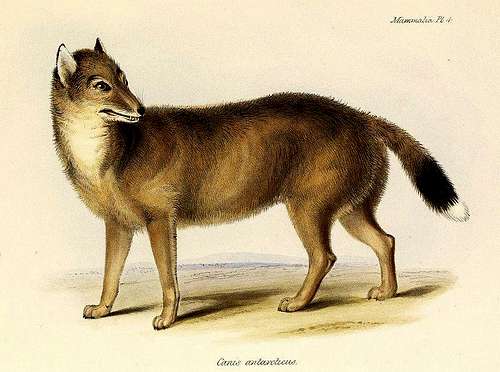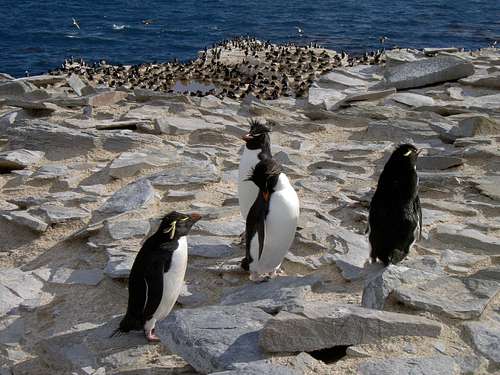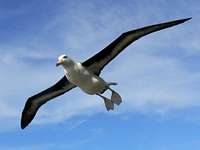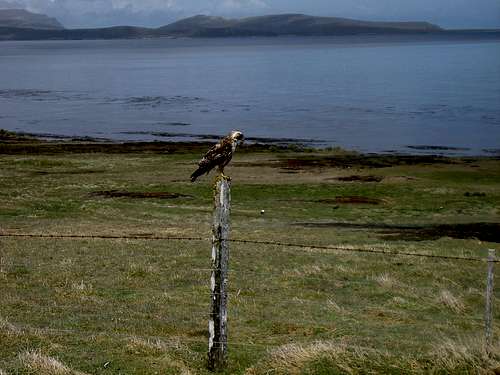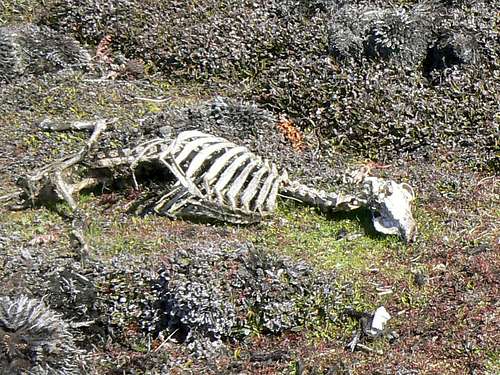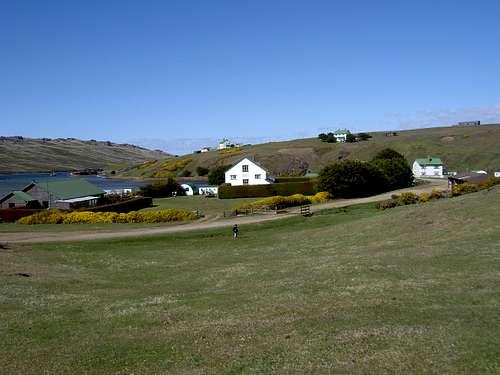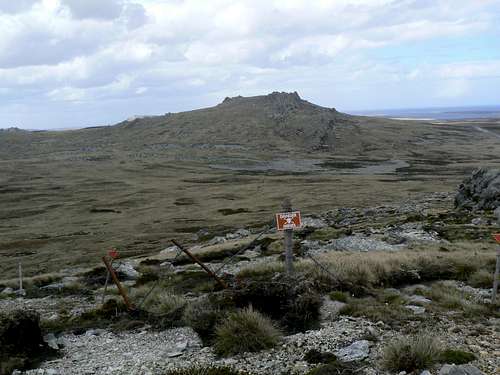-
 22275 Hits
22275 Hits
-
 94.82% Score
94.82% Score
-
 49 Votes
49 Votes
|
|
Area/Range |
|---|---|
|
|
51.84°S / 59.637°W |
|
|
Hiking |
|
|
Spring, Summer, Fall |
|
|
Introduction
Barren, windswept, treeless, remote, the Islands are part of a dwindling resource; one of the last remaining truly isolated places on the planet. This is the place to go if, like me, you have the occasional hankering to get as far away from people as possible.
Most visitors come to the Falklands first and foremost for wildlife viewing and I include below a synopsis of the incomparable opportunities that exist in this regard. SP-ers, however, want to know about the opportunities for outdoor and, principally, mountain based recreational activities that are possible in the Islands and this, therefore, will be the main focus of this page and those attached to it.
A Brief History
For such a remote and seldom visited place, the Falkland Islands have a remarkably complex history. This has everything to do with their strategic location as the last/first landfall before/after rounding Cape Horn and the (previously) rich whaling and (present) rich fishing opportunities that exist in the adjacent seas. Bearing in mind, however, that this is a website that features mountains, I will try to keep things as brief as is consistent with giving you the relevant facts. Familiarity with Falklands history will, however, cut lots of ice with your hosts down there when you go to visit.The very barrenness of the Islands served to keep them free from permanent colonisation until the 18th Century – although their existence was apparent on maps as early as the 16th Century, indicating that they may even have been known to Magellan. There is also evidence that Yaghan people, indigenous Tierra del Fuegans, certainly made landfall and may even have lived on the Islands.
The first European settlement on the Islands was established by France at Port St Louis on East Falkland in 1764. This is the origin of the name Îles Malouines after the Breton port of St Malo. Spain gained control of the Port St Louis settlement in 1767 and the new owners assumed the direct translation of the French name for the archipelago – Las Islas Malvinas.
At the same time that France was establishing Port St Louis, the British landed at Port Egmont on Saunders Island and built their own colony there in 1765. Neither the British nor Spanish parties were aware of the others existence at first. Once they were, however, armed fleets were dispatched by both sides and war was only averted by both agreeing to withdraw. Britain left behind a plaque proclaiming sovereignty over the Islands. And when Spain finally abandoned its colony in 1811 they did likewise.
After Spain finally withdrew from all of her American possessions and as her perceived natural successor in the region, the United Provinces of the River Plate, later to become Argentina, asserted sovereignty over the Islands and sent colonists to Port St Louis in 1824 under the leadership of Luis Vernet. In 1829 Vernet was formally named governor of the Islands. In 1831, however, he made the mistake of impounding three American sealing ships. The US promptly sent the USS Lexington south and the ship’s guns were used to effectively destroy the settlement.
In the meantime the British had become increasingly alarmed over Argentinean sovereignty assertions and the Lexington raid may have generated the vacuum they needed to re-assert their own claims. In 1833 Captain James Onslow commanding the brig HMS Clio arrived at Vernet's settlement at Port Louis and politely requested that the flag of the United Provinces of the River Plate be replaced with the British one. Outgunned and outmanned, the incumbents had no choice but to agree. The Islands have been under British rule ever since.
Given such a disputatious route to formal possession, Argentina declined to recognise British sovereignty. For almost 150 years the dispute festered. In the 1970’s the British government repeatedly sent mixed signals to Argentina, giving that country monopolies over such matters as air transport and supply of fuel to the Islands. Whilst publically declaring that the Islanders’ wishes were paramount and acknowledging that these would likely never embrace Argentinean control, the Foreign and Colonial Office nevertheless encouraged the Islanders to become more and more dependent on their large and powerful neighbours to the west.
Encouraged by this as well as the lack of progress in even discussing formal sovereignty and certainly driven by the need to divert its citizens’ attention from a brutally repressive military dictatorship and an economy on the verge of collapse, Argentina summarily invaded the Islands on April 02, 1982. The ruling junta was probably sure that Britain would, after suitable posturing to the contrary, eventually walk away from a colonial anachronism 8,000 miles away in the middle of nowhere. Unfortunately for many young men and women on both sides, this didn’t happen.
The British equipped and dispatched a military task force in just a few days. The force eventually made a landing at San Carlos, fought its way overland via Goose Green and, by late May, was facing a largely conscript Argentine army in the low mountains to the west of Stanley. A series of short and violent engagements, fought mostly at night, culminated in the surrender of the Argentine forces on June 14.
The Falklands War was, unsurprisingly, the defining event in the Islands’ modern history. In the aftermath, the old “sheepocracy” of the sometimes paternalist, sometimes usurious Falkland Island Company was broken up as part of the Shackleton Report. Private ownership of land became the norm. From a low of less than 1,900 inhabitants before the war, the population is now at a healthy level of over 3,000 not counting the “squaddies” based at the permanent British Forces base at Mt Pleasant.
The Islands modern economy has benefitted from tourism and from the lucrative sale of fishing licenses. Before the war there simply wasn’t the administrative wherewithal in place and foreign fishing vessels were accustomed to plundering the Islands’ rich territorial waters for free.
For the current generation this means a level of individual wealth and a standard of living never before experienced by Falklanders. Signs are everywhere. Huge public infrastructure improvements – the new hospital and school in Stanley and the wind farm on the Mt Pleasant road for instance. Alongside the traditional cottages of yesteryear, in Stanley and in Camp, are lots of big new homes that wouldn’t be out of place in the UK’s Surrey stockbroker belt. Smart new SUV’s outnumber old Land Rovers. Even that old Stanley stalwart, The Upland Goose pub, has been sold and converted to modern apartments.
Under the 1985 constitution the Falkland Islands Government (FIG) became a parliamentary representative democratic dependency, with the British appointed governor as head of government and representative of the Queen. Members of the FIG are democratically elected. Islanders think of themselves as Falklanders first and British second (and some not at all).
The Islands enjoy particularly warm ties with Chile and the demographics of the Islands now include sizeable communities from that country as well as from the “neighbouring” British possession of St Helena.
Almost 180 years after the dispute arose and 27 years after the conclusion of the war, Argentina continues to claim sovereignty over the Islands.
Falklands Geography
The capital, Stanley, is located on East Falkland and is home to about 2,200 of the current population (2008 census) of just over 3,100. Apart from Stanley the largest population centres are Goose Green on East Falkland – about 50 people and Port Howard on West Falkland – about 30 people. The remainder of the population is spread out over the “Camp” (from “campos”) the local term for anywhere outside Stanley.
Both main islands and many of the smaller islands have mountain ranges. West Falkland is generally mountainous, whereas East Falkland mountains span a west to east arc in the north part of the island from San Carlos to the outskirts of Stanley. The flat, boggy southern plains of East Falkland are known as “Lafonia” after Samuel Lafontaine, a Montevideo meat merchant who made a fortune from the feral cattle left there by earlier settlers. The highest point on the Islands is Mount Usborne (705 m) on East Falkland. See “Mountains” below for more detail.
Although the southern latitude is no more extreme than say, northern Vancouver Island, London or Berlin, the climate and consequently vegetation is heavily impacted by the prevailing westerlies and cold sea currents originating in the Antarctic. “Summer” weather includes sunshine one minute and a snowstorm/white-out the next.
Soil quality and depth is poor. Lowlands and the lower mountainsides are covered in white grass and bracken giving the overall landscape a brown, drab look. Higher up the mountains, diddle-dee, a heather-like plant, and balsam bog take over. Most of the land is used as pasture for sheep. See “Flora” below for further details.
Getting There
The continued unspoiled state of the Falklands owes everything to their remoteness. Since the 1982 conflict with Argentina, travel to the Islands is easier but by no means convenient. It’s also not cheap.At least 90% of visitors to the Islands do so on board a cruise ship. This is very restrictive. Time ashore is limited and you’re confined to the standard offerings that everyone wants to see: Stanley, the king penguins at Volunteer Beach and a couple of the smaller offshore islands such as Carcass or Saunders if you’re lucky. There certainly won’t be any opportunities to go hiking.
Independent travel is the only way to see the Islands as they should be seen. This is limited but eminently possible. Assuming that you don’t have your own yacht, there are two choices to arrive by air.
1. The Falkland Island Airbridge is currently operated by the RAF and flies four times every two weeks from RAF Brize Norton, UK via Ascension Island.
2. LAN Chile flies every Saturday from Santiago with a stop in Punta Arenas. Once per month the flight stops in Rio Gallegos in Argentina en route. Currently this is the one and only example of commerce between the two countries. The limited schedule means, of course, that the minimum time you’ll be there is a week.
Both LAN and the Airbridge use at the new Mount Pleasant airport about 80 km south west of the capital, Stanley.
Travel Within the Islands
Before the 1982 war there were almost no roads on the Islands outside Stanley. Travel was on horseback or via the ubiquitous Land Rover. Falklanders are still amongst the best off-road drivers on the planet. An extensive postwar road building programme saw good all-weather dirt and gravel roads built to almost every settlement. Vehicle hire is possible but you will be required to agree not to drive across “Camp”. Getting “bogged” will result in a large penalty as well as providing locals with multiple opportunities to dine out on their stories of how and from where they dragged you out!As of 2008 there is now ferry service on the MV Concordia Bay from New Haven on East Falkland Island to Port Howard on West Falkland so you can effectively cover both main islands at your own pace.
Most independent visitors travel within the Islands on the Falkland Islands Government Air Service. FIGAS fly Britten Norman Islander aircraft to grass or dirt airstrips – and sometimes more imaginative places to land – at 29 destinations throughout the archipelago. This can be arranged independently but it’s much easier to let one of the local agencies look after everything. International Tours & Travel Ltd or Stanley Services Ltd will prepare a customized itinerary for wherever you want to go, including transfers, flights and accommodation. Note that FIGAS has a strict limitation on luggage weight at 20 kg/person. More is allowed but at the discretion of the pilot and at a surcharge.
Falklands Island Mountains
The oldest, underlying rocks in the Falkland Islands are gneiss and granite. Over the bedrock are layers of quartzite, sandstone, shale and mudstone. The modern forms of the mountains that have resulted from this geology have been shaped principally by the processes of glaciation and erosion.Falkland Island mountains are neither high nor particularly rugged. They’re often more like high heath land. Many summits, however, display a more rugged character. The persistent strong westerlies carry sand particles that, over time, have scoured the tops to expose sharp quartzite ridges some with bizarre shapes – this phenomenon is apparent on many of the low summits west of Stanley and on Mt Richards on Saunders Island and on Mt Maria on West Falkland in particular. Evidence of glacial action can be seen in glacial cirques below the summits of several of the higher mountains, notably Mt Usborne on East Falkland and Mt Adam on West Falkland.
A common phenomenon seen on mountains throughout the Islands is the so-called “stone-runs”. These rivers of stone look to be exactly that as they “flow” down the mountains between vegetated “banks” into the lowlands below. Falklanders often claim that they’re unique to the Islands and that their formation can’t be fully explained by any single action. They’re certainly not unique. I’ve seen good examples in Tasmania for instance. In terms of formation, most now agree that the runs are the remnants of quartzites formed by repeated cycles of freezing and thawing first breaking up and then sorting the rock during and after the last Ice Age. The top layer consists of usually quite large, sharp fragments of rock and is grey-white due to prolonged exposure to the elements. Lower down, however, the remnant layer that acts as a “roller” over which the upper layer moves, consists of much smaller ground-down rock which is red-brown due to staining by iron oxide. The most impressive runs are to be found on East Falkland. There are many excellent examples throughout the west/east arc of mountains in the north, most notably on Mt Usborne, the Wickham Heights and most of the low summits west of the capital. Those on the east slopes of Mts Kent, Challenger and Harriet can be readily seen from the road out to Mt Pleasant.
Attached pages give further details on many Falkland mountains, including how to reach and climb them.
Flora
In the early days of colonisation, the shoreline of most of the myriad islands in the archipelago was fringed by bright green tussock grass. Unhappily, generations of sheep had almost grazed this into non existence before the Island authorities and individual landowners began replanting and protecting remnants. Excellent stands may now be found on many islands such as Sea Lion, Carcass and Bleaker. Flying over the Islands also shows that many smaller islands that were never used for grazing retain their original stands of grass.Much of the lower reaches of the main islands are now covered in white grass. This provides some nutriment for sheep at the rate of about 4 acre/animal but again the authorities have begun experimenting with hardier more nutritient grasses for raising livestock.
At first sight the Falkland Islands look to be uniformly brown, drab and barren. Only the white-grey quartzite ridge tops and stone runs seem to break the monotony. Look closer, however, and you’ll find plenty of interesting and colourful plants to enjoy. In amongst the lowland grasses and sedges you’ll find chickweed, pink and white scurvy flower, rare silvery buttercup and, of course, pale maiden, the Islands national flower and many more in addition. If you can find them, there are even four types of native orchid.
There are no trees native to the Falklands but many imported specimens have been encouraged to grow. These often provide welcome wind breaks but are often grown just for pure satisfaction. Almost everywhere there are people you’ll find hardy gorse used for hedging. Flying over the Islands In spring, bright yellow hedges mark the settlements and, on the ground, their coconut scent fills the air.
Fauna
For 95% of visitors to the Falkland Islands, the wildlife is the single most compelling reason to go there. And who can blame them. The sheer numbers of species of birds and marine animals on view is simply astonishing, even before considering how approachable many of them are (more on this aspect later).A complete description of this aspect of the Falklands is far beyond the scope of this article and I’m no expert to boot. The following makes no attempt to be complete and for this I offer no apologies. So much information is available I couldn’t hope to even begin to do justice to it all. At the end of the article are hyperlinks to get anyone started on a thorough self education on the subject of Falklands fauna. For now, I hope that my paltry effort will suffice.
Land mammals
The only native mammal to have lived on the Falklands was Dusicyon culpaeus the Falkland Islands Wolf or Warrah. Once prevalent on both main islands, this fox-like creature had already been hunted into extinction by 1876.
In modern times the only wild land mammals on the islands are introduced rats, mice and feral cats whose main function seems to be to have a detrimental effect on ground nesting birds. Several of the smaller islands have managed to rid themselves of this scourge and several more have active programmes in place with the same aim.
Marine mammals
With their estimated 1,300 km of coastline the Falklands offer almost unlimited breeding grounds for several important species. Fur seals, the southern sea lion and elephant seals all breed on the islands whilst leopard seals are frequent visitors.
Whales and dolphins can often be seen close to shore. Almost all known southern hemisphere species have been observed in Falklands waters at one time or another but those most commonly seen close to shore are Commerson's dolphins, Peale's dolphins, pilot whales and orcas.
Shore Birds
This category, of course, contains many peoples’ first choice amongst Falklands must-see wildlife - penguins.
Five species breed in the islands: king, magellenic, gentoo, rockhopper and the occasional macaroni. Although there are several smaller colonies in the Islands, the king penguin colony at Volunteer Point is easily the most impressive at 400-500 breeding pairs. Gentoos and magellenics are found everywhere but you’d be hard pressed to beat the sand isthmus known as “The Neck” on Saunders Island for both species. Everyone’s favourite are the rockhoppers. The Charlie Chaplin of penguins, they have no fear of you and will happily waddle up to your feet and look enquiringly up as if expecting you to say something. The sea cliffs at the north end of Sea Lion Island is a great place to go to watch rockerhoppers blithely emerging from the pounding breakers and somehow hopping up the near vertical ground above. Now and again a renegade macaroni penguin can be spotted amongst breeding rockhoppers.
Second at least on my popularity scale to penguins are the thousands of black browed albatross to be found all along the north coast cliffs on Saunders Island. 80% Of the world’s breeding population of this species is found in the Falkands. You can literally sit on the cliff edge in the flight path as these huge birds come and go just inches away from your head.
Field Birds
With the arrival of warmer weather and longer days in November, the supposedly barren heathland throughout the Islands is alive with birdsong. Wrens, finches, thrushes, meadowlarks, siskins are just a few of the attractions for ornithologists from around the world.
Raptors are plentiful overhead on the lookout for lunch, as are turkey vultures, except that these carrion birds prefer their meat not to be moving. Striated caracara can often be seen around settlements. This curious and fearless bird is known as “Johnny Rook” to Islanders and gets his food anywhere he can. He hunts if he has to and is particularly fond of penguin eggs and chicks but he’ll take carrion if he can get it and any of your scraps you might leave around, edible or not.
Cautionary Notes
As I have indicated above, several Falkland species have no land based predators and will often approach you. Breeding penguins may often not be alarmed at your first approach and will then panic only when it’s too late to avoid damage to eggs. STAY WELL AWAY FROM WILDLIFE, NO MATTER HOW TEMPTING IT IS TO APPROACH. Many viewing sites post recommended minimum viewing distances. Take careful note of any instructions and act upon them.
Don’t even think about approaching sea elephants and sea lions! If you are approaching through tall tussock be alert to these animals in the grass. They can move a lot faster than you.
Lastly, for those of a more sensitive nature, be aware of the following. Life is everywhere on the Falklands but so is death. The climate and environment is harsh and the struggle for life unremitting. Many, many animals and birds lose this struggle every day. There are decomposed, partially devoured carcasses and animal skeletons strewn over the land everywhere you go. It’s not a pretty sight but is an accurate reflection of the realities of life in this wonderful but harsh place.
Accommodation etc
In Stanley itself you will find the whole range of accommodation options from comfortable hotels to well appointed B & B’s. Outside Stanley there are some lodges that have been developed to attract tourists – at Port Howard and Darwin and on Sea Lion and Pebble Islands for instance – but oftentimes you will visit a location where, apart from the settlement family, you are the only other person there. On these occasions you might stay in the family house or in an adjoining cottage set aside for visitors.No matter where you stay but especially if you’re being catered to in Camp, be prepared for some serious eating. Falklanders love their grub and they appreciate any visitors who share this passion. As well as the usual three meals a day, be ready for “smoko”. This tradition might be what the English used to call “high tea”. In any event it’s tea or coffee and lots and lots of home baked goodies. Try to pace yourselves. Smoko is usually at 4 pm and 3-4 hours later you’ll have a multi-course dinner in front of you. Falkland Islanders are amongst the most laid back and easiest going folk on the planet but I could swear that, on one occasion after a full breakfast, lunch and smoko at 4, our host looked almost angry when we had to refuse her home-made ice-cream dessert. You’ve been warned!
Accommodation arrangements can be made directly, although I’ve found it very convenient to make all prior bookings through the local companies International Tours & Travel Ltd or Stanley Services Ltd referred to above.
I would suppose that for all those hardy folk out there, camping is allowed pretty well everywhere on the Islands. But – all land is private, so be prepared to contact the landowner in advance.
Red Tape
Entry into the Falklands is as for the UK. For most nationalities this means a passport but a visa is required for nationals of some countries, notably Argentina. Enquire at your local UK consulate. A condition of landing on the Islands is that you have a return ticket, funds to cover your expenses whilst there and accommodation reserved for at least the first 2 or 3 nights of your stay. In practice, if you arrive without a reservation, the nice immigration people phone around Stanley until they find someone with a bed available before letting you out of the airport.All land in the Falklands is privately owned. Any activities you undertake must be with the permission of the local landowner.
It goes without saying that photographing any of the military installations around the islands is strictly forbidden. In case anyone is foolish enough to consider otherwise, entering a marked minefield is illegal and carries a heavy fine (or worse!)
Falklands Weather
Current weather in StanleySources & Useful Links
There is now a huge amount of information on the internet on the Falkland Islands. In this section I have included those links that I’ve found most useful whilst researching this article or have actually used on the ground whilst there. In general I have documented one link per subject when, in fact, there are scores available. In general, however, you will be able to use each link to jump into identical or complementary sites from other sources.
Falkland Islands History
The Shackleton Report
The Falklands Islands Government
Falklands Tourism
International Tours and Travel
Stanley Services Ltd
Falkland Islands Government Air Service
East/West Falkland ferry service
The Falklands War
Accomodation & tourist facilities in Stanley and Camp
Internet and cellphone service in the Falkland Islands
Wildlife
Falklands FloraFalklands Fauna


